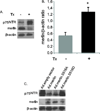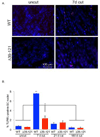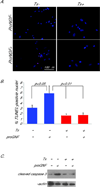Merlin status regulates p75(NTR) expression and apoptotic signaling in Schwann cells following nerve injury
- PMID: 26057084
- PMCID: PMC4641051
- DOI: 10.1016/j.nbd.2015.05.021
Merlin status regulates p75(NTR) expression and apoptotic signaling in Schwann cells following nerve injury
Abstract
After nerve injury, Schwann cells (SCs) dedifferentiate, proliferate, and support axon regrowth. If axons fail to regenerate, denervated SCs eventually undergo apoptosis due, in part, to increased expression of the low-affinity neurotrophin receptor, p75(NTR). Merlin is the protein product of the NF2 tumor suppressor gene implicated in SC tumorigenesis. Here we explore the contribution of merlin to SC responses to nerve injury. We find that merlin becomes phosphorylated (growth permissive) in SCs following acute axotomy and following gradual neural degeneration in a deafness model, temporally correlated with increased p75(NTR) expression. p75(NTR) levels are elevated in P0SchΔ39-121 transgenic mice that harbor an Nf2 mutation in SCs relative to wild-type mice before axotomy and remain elevated for a longer period of time following injury. Replacement of wild-type, but not phospho-mimetic (S518D), merlin isoforms suppresses p75(NTR) expression in primary human schwannoma cultures which otherwise lack functional merlin. Despite elevated levels of p75(NTR), SC apoptosis following axotomy is blunted in P0SchΔ39-121 mice relative to wild-type mice suggesting that loss of functional merlin contributes to SC resistance to apoptosis. Further, cultured SCs from mice with a tamoxifen-inducible knock-out of Nf2 confirm that SCs lacking functional merlin are less sensitive to p75(NTR)-mediated cell death. Taken together these results point to a model whereby loss of axonal contact following nerve injury results in merlin phosphorylation leading to increased p75(NTR) expression. Further, they demonstrate that merlin facilitates p75(NTR)-mediated apoptosis in SCs helping to explain how neoplastic SCs that lack functional merlin survive long-term in the absence of axonal contact.
Keywords: Axotomy; Cell death; Nerve growth factor; Neurofibromatosis type 2; Receptor; Schwann cells.
Copyright © 2015 Elsevier Inc. All rights reserved.
Figures







References
-
- Alam SA, Robinson BK, Huang J, Green SH. Prosurvival and proapoptotic intracellular signaling in rat spiral ganglion neurons in vivo after the loss of hair cells. The Journal of comparative neurology. 2007;503:832–852. - PubMed
-
- Alfthan K, Heiska L, Gronholm M, Renkema GH, Carpen O. Cyclic AMP-dependent protein kinase phosphorylates merlin at serine 518 independently of p21-activated kinase and promotes merlin-ezrin heterodimerization. J Biol Chem. 2004;279:18559–18566. - PubMed
-
- Bandtlow C, Dechant G. From cell death to neuronal regeneration, effects of the p75 neurotrophin receptor depend on interactions with partner subunits. Science's STKE : signal transduction knowledge environment. 2004;2004:pe24. - PubMed
-
- Barker PA. p75NTR is positively promiscuous: novel partners and new insights. Neuron. 2004;42:529–533. - PubMed
Publication types
MeSH terms
Substances
Grants and funding
LinkOut - more resources
Full Text Sources
Other Literature Sources
Medical
Molecular Biology Databases
Research Materials
Miscellaneous

